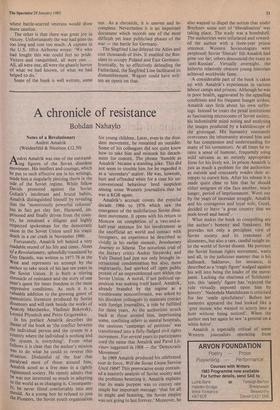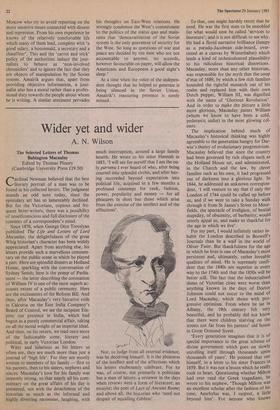A chronicle of resistance
Bohdan Nahaylo
Notes of a Revolutionary Andrei Amalrik
(Weidenfeld & Nicolson £12.50) ndrei Amalrik was one of the outstand- ing figures of the Soviet dissident movement. His intellect and courage, which he put to such effective use in his writings, made him a singularly piercing thorn in the side of the Soviet regime. While fellow Davids protested against the Soviet Goliath's intolerant and brutal habits, Amalrik distinguished himself by revealing that the 'monstrously powerful colossus' has in fact got clay feet. Harassed, im- prisoned and finally driven from the coun- try, he remained a diligent and highly respected spokesman for the democratic cause in the Soviet Union until his tragic death in a car crash in November 1980.
Fortunately, Amalrik left behind a very readable record of his life and times. Notes of a Revolutionary, splendidly translated by Guy Daniels, was written in 1977-78 in the West and represents an attempt by the author to take stock of his last ten years in the Soviet Union. It is both a stirring chronicle of resistance and the story of one Man's quest for inner freedom in the most oppressive conditions. As such it is a valuable addition to the growing genre of tnemoiristic literature produced by Soviet dissenters and will rank beside the works of Anatoly Marchenko, Vladimir Bukovsky, Leonid Plyushch and Petro Grigorenko.
In his preface Amalrik describes the theme of the book as 'the conflict between the individual person and the system in a country where the individual is nothing and the system is everything'. From what follows it is clear that the author's mission was to do what he could to reverse this situation. Disdainful of the fear that Paralysed most of those around him, Amalrik acted as a free man in a tightly regimented society. He openly admits that he was not interested so much in adapting to the world as in changing it. Consequent- ly, he never fitted comfortably into any mould. As a young boy he refused to join the Pioneers, the Soviet youth organisation for young children. Later, even in the dissi- dent movement, he remained an outsider. Some of his colleagues did not quite know how to take him and mistook his detach- ment for conceit. The phrase 'humble as Amalrik' became a standing joke. This did not seem to trouble him for he regarded it as a `secondary' matter. He was, however, hurt and offended when for a time his un- conventional behaviour bred suspicion among some Western journalists. that he was a KGB agent.
Amalrik's account covers the eventful decade 1966 to 1976 which saw the emergence of the multifarious Soviet dissi- dent movement. It opens with his return to Moscow on completion of a two-and-a- half-year sentence for his involvement in the unofficial art world and contact with foreigners, an experience he described so vividly in his earlier memoir, Involuntary Journey to Siberia. The notorious trial of the literary critics Andrei Sinyaysky and Yuly Daniel had just not only brought in- ternational condemnation but also, more importantly, had sparked off open public protest of an unprecedented sort within the Soviet Union. A moral, if not political op- position was making itself heard. Amalrik, already branded by the regime as a troublesome nonconformist, was asked by his dissident colleagues to maintain contact with foreign journalists, a role he fulfilled for three years. As the authorities struck back at those around him, imprisoning some, confining others in mental hospitals, the cautious 'campaign of petitions' was transformed into a fully-fledged civil rights movement. For several years its participants used the name that Amalrik and Pavel Lit- vinov suggested in 1968 — the 'Democratic Movement'.
In 1969 Amalrik produced his celebrated tour de force, Will the Soviet Union Survive Until 1989? This provocative essay contain- ed a masterly analysis of Soviet society and the problems besetting it. Amalrik explains that its main purpose was to convey one simple but important message: 'that for all its might and boasting, the Soviet empire was not going to last forever.' Moreover, he
also wanted to dispel the notion that under Brezhnev some sort of 'liberalisation' was taking place. The study was a bombshell. The authorities were infuriated and reward- ed the author with a three-year prison sentence. Western Sovietologists were perplexed; Soviet 'liberals' felt Amalrik had gone too far; others denounced the essay as `anti-Russian'. Virtually overnight, the hitherto relatively obscure young historian achieved worldwide fame.
A considerable part of the book is taken up with Amalrik's experiences in various labour camps and prisons. Although he was in poor health, aggravated by the appalling conditions and his frequent hunger strikes, Amalrik says little about his own suffer- ings. Instead he treats the penal institutions as fascinating microcosms of Soviet society, his indomitable mind noting and analysing the images produced by a kaleidoscope of the grotesque. His humanity constantly overcomes the inhumanity around him and he has compassion and understanding for many of his tormentors. At all times he re- tains a sense of humour, frequently using mild sarcasm as an entirely appropriate form for his lively wit. In prison Amalrik is just as much a problem for the authorities as outside and constantly evades their at- tempts to outwit him. After his release it is made quite clear to him that he should either emigrate or else face another, much longer, period of imprisonment. Worn out by the years of incessant struggle, Amalrik and his courageous and loyal wife, Gusel, decided to leave 'a great country that we both loved and hated'.
What makes the book so compelling are the author's honesty and frankness. He provides not only a percipient view of Soviet society and its treatment of dissenters, but also a rare, candid insight in- to the world of Soviet dissent. He portrays the Soviet human rights movement, warts and all, in the judicious manner that is his hallmark. Sakharov, for instance, is described as a 'tragic figure' nudged against his will into being the leader of the move- ment. Lacking the charisma of Solzhenit- syn, this 'saintly' figure has 'rejected the role virtually imposed upon him by history'. Nadezhda Mandelstam is criticised for her 'senile spitefulness'. Before her memoirs appeared she had looked like a `grey mouse who wanted to scurry into a hole without being noticed'. When the author met her again he saw 'a general on a white horse'.
Amalrik is especially critical of some Western journalists operating from Moscow who try to avoid reporting on the more sensitive issues connected with dissent and repression. From his own experience he knows of the relatively comfortable life which many of them lead, complete with 'a good salary, a housemaid, a secretary and a chauffeur'. This and the 'carrot and stick' policy of the authorities induce the jour- nalists to behave as 'non-involved chroniclers' and to ignore the fact that they are objects of manipulation by the Soviet system. Amalrik argues that, apart from providing objective information, a jour- nalist also has a moral rather than a profes- sional duty towards the people about whom he is writing. A similar sentiment pervades his thoughts on East-West relations. He strongly condemns the West's commitment to the politics of the status quo and main- tains that 'democratisation of the Soviet system is the only guarantee of security for the West. So long as questions of war and peace are decided by ten men who are not accountable to anyone, no accords, however favourable on paper, will allow the Americans and Europeans a good night's sleep.'
At a time when the voice of the indepen- dent thought that he helped to generate is being silenced in the Soviet Union, Amalrik's reassuring presence is sorely missed.







































 Previous page
Previous page